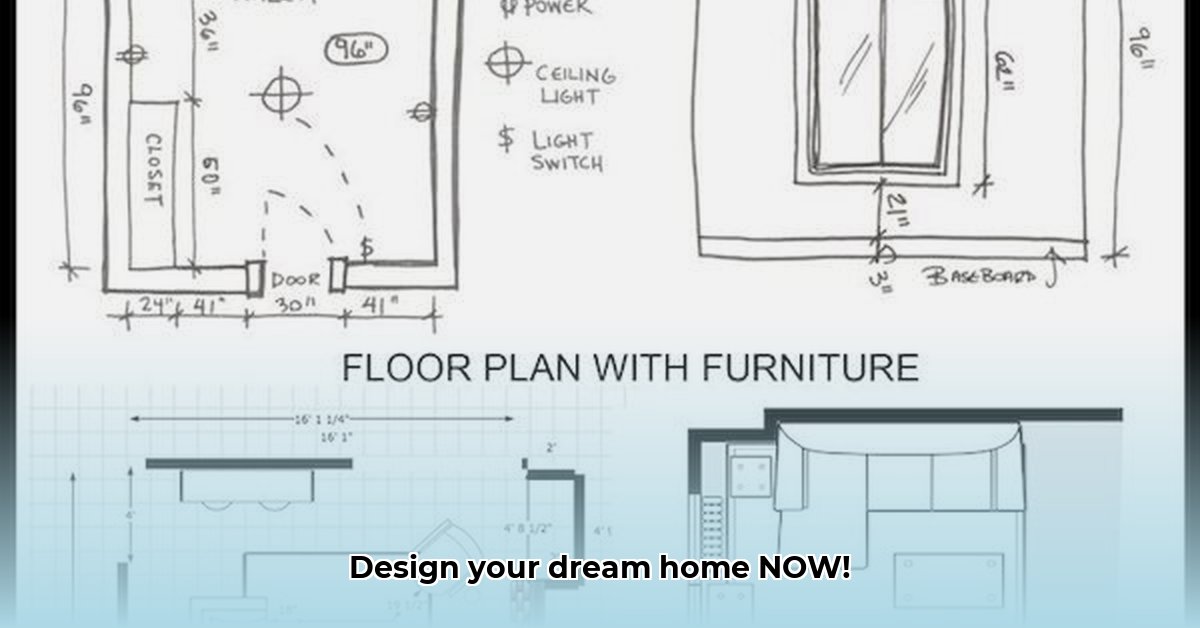Ever wished your home was exactly how you wanted it? Designing your own floor plan is the secret, and it’s simpler than you might think! This guide will show you how to create a floor plan that’s both beautiful and practical – a home that truly works for you. We’ll walk you through everything, from simple drawing basics to clever tricks for maximizing space and light, all while making sure you avoid any expensive mistakes. Whether you’re buying your first home or renovating, you’ll be surprised how easy it is to turn your dream home into a reality. For more detailed guidance, check out this helpful resource on how to draw a floor plan.
Floor Plan Drawing Tips: Design Your Dream Home Now
Let’s face it: designing your own home can feel overwhelming. But with a little planning and these helpful tips, you’ll be amazed at what you can achieve. This isn’t about becoming an architect overnight; it’s about empowering you to create a floor plan that truly works for you.
Understanding Your Needs and Space: The Foundation of Your Dream Home
Before you even think about drawing a line, ask yourself some crucial questions. What kind of life do you want to live in this house? Imagine your daily routine – how will you use each space? Do you need a massive kitchen for family gatherings, a cozy reading nook bathed in sunlight, a home office with enough room for two people to work comfortably, or a playroom that can handle the wildest games? Think about everyone who will live there – now and in the future. Kids growing up? Aging parents moving in? Remote work becoming permanent? Planning ahead now saves you from expensive remodels down the road. To ensure a great floor plan, consider these elements:
- Lifestyle Assessment: Evaluate your daily routines, hobbies, and work habits.
- Future Planning: Think about how your needs may change over time, including family size, career shifts, and accessibility requirements.
- Room Prioritization: Determine which spaces are most important to you and allocate space accordingly. Consider a multi-purpose room if square footage is limited.
Now, grab your measuring tape! This isn’t optional. Seriously, get those accurate measurements of your property and existing furniture. This is the bedrock of your whole design. Every wall, every window, every nook and cranny needs measuring – even those oddly shaped spaces. Note the placement of electrical outlets, light switches, and plumbing fixtures. Trust me, this step prevents costly mistakes later. Accurately recording all dimensions is key during spatial planning and home layout optimization.
Sketching Your Layout: Unleash Your Inner Architect (No Experience Required!)
Grab a pen and paper (or your tablet if you prefer – no judgements!), and start sketching. Don’t stress about making it perfect; these are just brainstorming visuals. The goal is to get your ideas down. Think about how you want to move through the house. Experiment! Swap the kitchen and living room around. Try putting the master bedroom on the opposite side of the house away from the kids’ rooms. Consider different shapes for rooms – a curved wall can add visual interest. This is your chance to play with different arrangements. Consider these elements while sketching:
- Bubble Diagrams: Create simple shapes to represent rooms and their relationships.
- Spatial Relationships: Experiment with different arrangements to optimize flow.
- Sunlight Direction: Note the path of the sun during different times of the day.
Refining Your Design: Adding the Important Details
Now that you have a rough layout, let’s add some detail. Think about traffic flow – how people move through the home. Are there any bottlenecks? Will everyone be bumping into each other in a small hallway? Consider how natural light will work. Where will the sun shine? Can you strategically place windows to bring in sunlight? And don’t forget storage! Closets, pantries, a garage – plan for plenty. Poor storage planning is a common mistake that’ll haunt you later. Consider these aspects when refining to maximize functionality:
- Traffic Patterns: Draw lines representing common walking paths to identify potential congestion points.
- Lighting Strategy: Determine window sizes and placements to maximize natural light and minimize glare.
- Storage Solutions: Think vertically and explore built-in options to maximize storage space.
Advanced Tips for an Exceptional Design
Let’s take things up a notch. Here are a few ideas to create a truly functional home:
- Kitchen Magic: For a kitchen that flows smoothly, aim for the classic “work triangle” – the refrigerator, sink, and stove forming a triangle. Also, consider the placement of your microwave, dishwasher, and garbage disposal for maximum convenience. It’s almost magic how much more efficient it makes the kitchen feel!
- Bathroom Bliss: Ensure enough space around toilets, sinks, and showers. Think about double sinks in the master bath. You’ll be surprised at how much you’ll appreciate that extra space. Consider a separate toilet room for added privacy, and plan for adequate ventilation to prevent moisture buildup.
- Hallway Harmony: Avoid those narrow, cramped hallways. They can seriously make your whole house feel smaller. Aim for hallways that feel spacious and inviting. Consider adding built-in shelving or artwork to make hallways more functional and visually appealing.
From Sketch to Software: Bringing Your Vision to Life
Your hand-drawn sketches are a great start, but now it’s time to take things to the next level. There’s a raft of software out there, from simple free online tools like Planner 5D and Floorplanner to more professional options like SketchUp and AutoCAD. Choose one that fits your comfort level and go to town creating a scaled version of your floor plan. This lets you play with dimensions and “see” your home in a realistic way. Utilizing digital tools provides accuracy to spatial arrangement and interior design planning. Features to look for in floor plan software include:
- Drag-and-Drop Interface: Simplifies the process of adding and arranging elements.
- 3D Visualization: Allows you to see your floor plan in three dimensions.
- Measurement Tools: Ensures accuracy and adherence to scale.
This is also your chance to check local building codes. Make sure your design meets the requirements for room sizes, window placement (for things like emergency exits), ceiling heights, and other safety regulations. Don’t skip this – it could save you a lot of trouble later.
The Art of Iteration: It’s Okay to Change Your Mind!
Designing a home isn’t a one-and-done process. Expect to go through a few (or several!) revisions. Moving things around and making changes is perfectly normal. Don’t be afraid to tweak your plans. Get feedback from friends, family, or even a professional designer. In fact, those tweaks are what will help you create the home of your dreams. Things to consider are:
- Seek Feedback: Share your plans with others and be open to suggestions.
- Embrace Flexibility: Be willing to make changes based on new information or insights.
- Focus on Functionality: Prioritize practical considerations over purely aesthetic choices.
Your Floor Plan Checklist: A Quick Guide to Success
| Item | Description | Importance |
|---|---|---|
| Accurate Measurements | Measure everything precisely, including walls, windows, doors, and existing furniture. This is non-negotiable. | Prevents major problems and costly mistakes later. |
| Needs Assessment | Define your lifestyle, family needs, and how you envision using each space. Consider both current and future needs. | Ensures the plan reflects your needs and avoids future regrets. |
| Sketching | Rough sketches allow you to visualize different room arrangements and explore possibilities. Experiment with different layouts. | Helps you brainstorm and see the big picture before getting into details. |
| Detailing | Add the finer points: fixtures, furniture, and ensuring sufficient storage space. Plan for electrical outlets and lighting. | Optimizes functionality and makes your dream home a reality. |
| Software Use | Use software for scaled drawings, helping visualize dimensions and improving accuracy. Explore 3D visualization features. | Creates a clear, professional-looking plan. |
| Code Compliance | Verify your design adheres to all applicable building codes and regulations. Pay attention to requirements for room sizes and window placement. | Avoids legal issues and safety hazards. |
| Review & Refinement | Regularly review and revise, refining your plan based on feedback and evolving ideas. Be open to making changes. | Ensures your final design reflects your vision and needs. |
Remember, creating your dream home is a journey. Use these tips, and embrace the process. It’s okay to adjust and change your mind—that’s a big part of making it truly ‘yours.’ Soon, you’ll have the perfect floor plan!
How to Improve Home Design Flow and Privacy
Key Takeaways:
- Accurate measurements are fundamental for a successful floor plan.
- Prioritizing traffic flow is essential for optimizing home usage.
- Future-proofing the design accommodates changing family needs.
Planning Your Space: Defining Zones for Flow and Privacy
Before you even start sketching, think about how you live. What are the essential areas of your home? Define zones: public (living room, kitchen, dining room), private (bedrooms, bathrooms, home office), and functional (laundry, garage, storage). Smart zoning is key to
- Gray Kitchen Backsplash Ideas: Find Your Perfect Gray Tile - December 11, 2025
- Glass Wall Tiles For Bathroom: A Stylish, Durable Choice - December 10, 2025
- Glass Mosaic Kitchen Backsplash: Add Shimmer and Style - December 9, 2025









